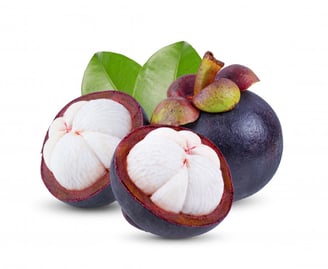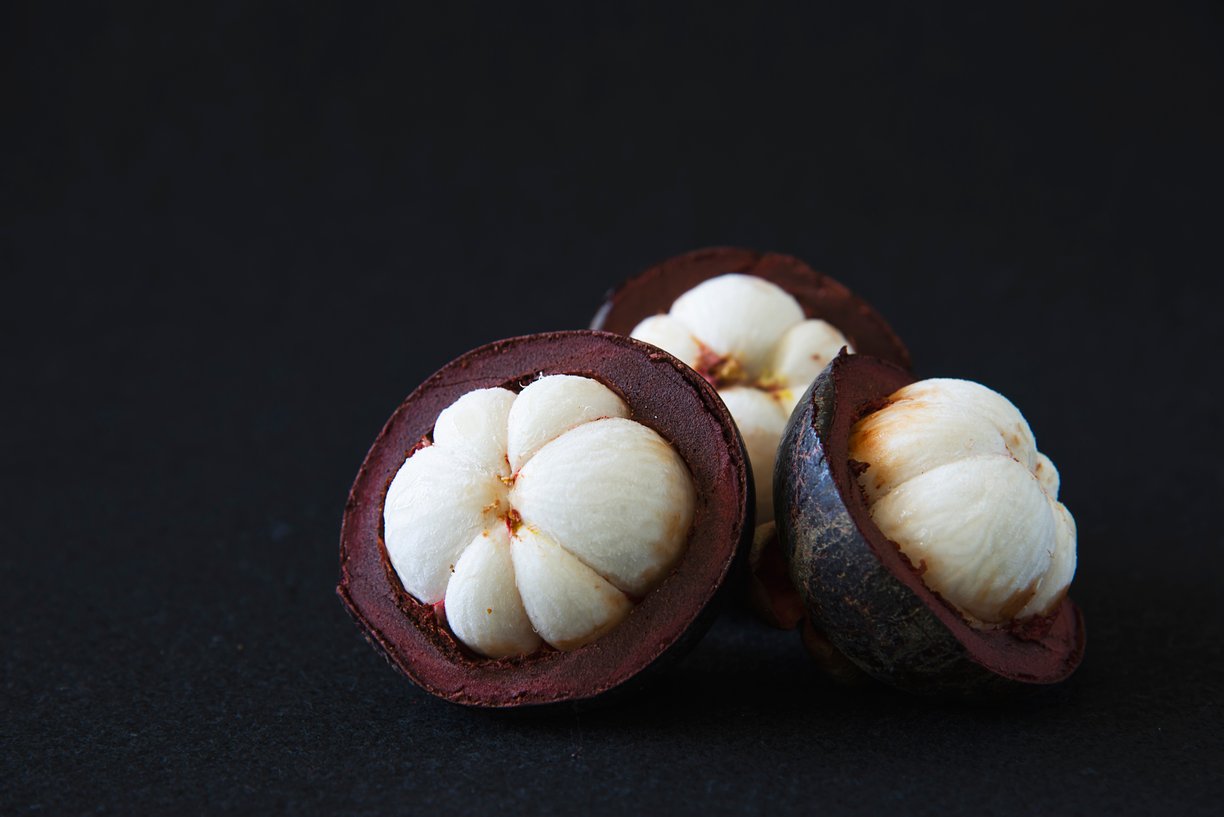Mangosteen
Mangosteen is a small, purple fruit from Southeast Asia. It has a hard outer skin & sweet, white, juicy flesh. This exotic, tropical fruit with a slightly sweet & sour flavor. People have described its taste as a mix of lychee, peach, strawberry, & pineapple. Mangosteen produces dark-purple or red-purple fruit with the soft, thick rind
HEALTHY & FUN FRUITY FACTS


Mangosteen
Mangosteen is a small, purple fruit from Southeast Asia. It has a hard outer skin & sweet, white, juicy flesh. This exotic, tropical fruit with a slightly sweet & sour flavor. People have described its taste as a mix of lychee, peach, strawberry, & pineapple.
Mangosteen produces dark-purple or red-purple fruit with a soft, thick rind on the surface. The flesh consists of 4 to 8 juicy, triangular segments that are white-colored. Each segment contains 1 to 4 seeds. Rind & seed are not edible.
Farmers tend to grow mangosteen in Indonesia, Malaysia, Sri Lanka, the Philippines, & Thailand. In these countries, people consume it as fruit, juice, traditional medicine, ice-creams, sorbets, mousses, yogurts, smoothies, cocktails & salad dressings.
The rind of mangosteen is used for leather tanning in China.
Mangosteen is often labeled as "superfruit" due to its high content of antioxidants (substances that prevent cell damage) & because of its high nutritional value.
The dried rind of mangosteen can be used in the treatment of dysentery, diarrhea, ulcers, pain, infected wounds, fever, & skin disorders such as eczema.
Mangosteen is the national fruit of Thailand.
Mangosteen is a perennial plant that can survive more than 100 years in the wild.
Fresh mangosteen is hard to find in the United States for two reasons.
First, mangosteen trees need a fully tropical climate & lots of time to grow. Small farms in Hawaii & Puerto Rico, which started in the 1990s, are only now starting to bear fruit.
Mangosteen produces pinkish-white flowers that grow solitary or arranged in pairs. Male & female flowers develop on separate trees (dioecious plants). Mangosteen is an apomictic plant, which means that female trees produce fruit without pollination.
Mangosteen tree starts to bear fruit 7 to 10 years after planting. It produces fruit two times per year. Depending on the age of the tree, mangosteen can produce from 200 to 3.000 fruit per season (older trees produce more fruit). Mangosteen is available from June to October.
Second, fresh mangosteen can harbor quarantine pests or non-U.S. native bugs that could threaten the ecosystem. It means mangosteen importers must sterilize the fruit before it enters the country. This sometimes affects the quality, taste, or shelf life.
Most fruits, including mangosteen, are low in fat, sodium, & calories, helping people maintain a moderate weight. They are also free from cholesterol.
The fruit, fruit juice, rind, twig, & bark are used as medicine.
Mangosteen provides a variety of essential vitamins, minerals, & fiber while being low in calories. These nutrients are important for maintaining many functions in your body.
A 1-cup (196-gram) serving of canned, drained mangosteen offers:
Calories: 143
Carbs: 35 grams
Fiber: 3.5 grams
Fat: 1 gram
Protein: 1 gram
Vitamin C: 9% of the Reference Daily Intake (RDI)
Vitamin B9 (folate): 15% of the RDI
Vitamin B1 (thiamine): 7% of the RDI
Vitamin B2 (riboflavin): 6% of the RDI
Manganese: 10% of the RDI
Copper: 7% of the RDI
Magnesium: 6% of the RDI
The vitamins & minerals in mangosteen are important for maintaining many bodily functions, including DNA production, muscle contraction, wound healing, immunity, & nerve signaling.
Moreover, a single cup (196 grams) of this fruit provides almost 14% of the RDI for fiber — a nutrient often lacking in people’s diets. Plant compounds & fiber in mangosteen may have anti-inflammatory effects according to animal research. More studies are needed to understand how this fruit may reduce inflammation in humans.
Mangosteen contains vitamins with antioxidant capacity, as well as a unique class of antioxidant compounds known as xanthones. Test-tube & animal research indicates that xanthones in mangosteen may protect against cancer. However, high-quality human research on this topic is lacking.
Some animal & human research suggests that mangosteen may play a role in weight loss & obesity prevention. Still, more studies are needed.
Plant compounds & fiber in mangosteen may contribute to reduced blood sugar. Still, current research is insufficient.
Research suggests that mangosteen may increase your number of immune cells & reduce inflammation — potentially boosting immune health.
Research suggests that antioxidants & anti-inflammatory compounds in mangosteen may protect skin cells from damage associated with sun exposure & aging.
Research suggests that nutrients & other plant compounds in mangosteen may support optimal digestive, heart, & brain function.


